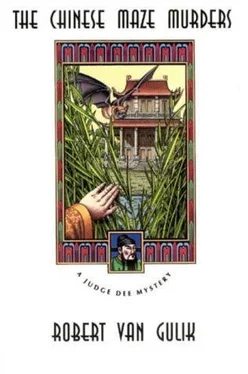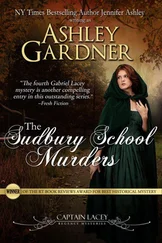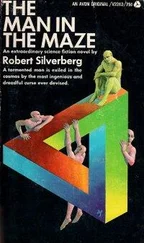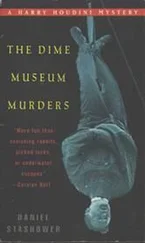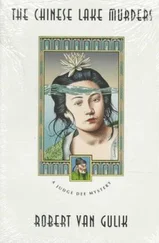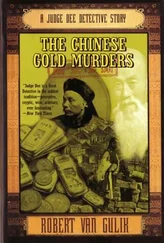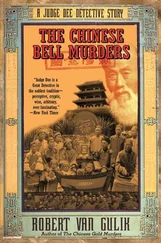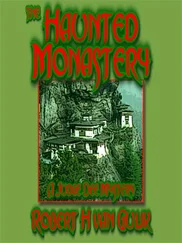The plot of the girl with the severed head is a quite common one in old Chinese crime stories; cf., for instance, my translation of the T'ang-yin-pi-shih, Case 64-A. I worked it into a story centering round sapphism, an aberration described in a number of Chinese novels and plays. The best known example is the love story of the girl Ts'ao Yü-hua and Mrs. Fan Yün-chien, in the 17th century play Lien-hsiang-pan, by the famous artist and playwright Li Yü. Cruelty of women towards women servants etc. is amply illustrated in Chinese 'romans de moeurs'; I mention as an example Chapter VIII of the well known novel Chin-p'ing-mei. The frequent occurence of sapphism, and occasional cases of sadism among women in ancient China must doubtless be ascribed to the polygamic family system, where a number of women were obliged to live in constant and close proximity. Students of sociology will find this problem discussed at some length in my book 'Erotic Colour Prints of the Ming Period' (Tokyo 1951, Vol. I, p. 146-148). I selected this motive for inclusion in the present novel partiy because it enabled me to create unexpected
developments and partly in order to show how surprisingly 'modern' old Chinese plots can be.
The exposure of the three monks who falsely reported the theft of a golden statue, in Chapter VII of the present novel, is based on a story in-the T'ang-yin-pi-shik, the collection of criminal cases mentioned above. This particular case will be found on page 159 of my translation, Case 57-B.
The 'framework' of the present novel, viz. a tale of a distant town where a local bully has usurped power, also is a common situation in Chinese novels. Sometimes a clever magistrate outwits and deposes the usurper, sometimes it is the usurper who is the hero of the story. He takes over from a corrupt magistrate, and subsequently is officially confirmed in his position by a grateful government.
Finally, the role played by 'Master Crane Robe' in this novel (see Chapter XIX) is a much-chastened version of the 'deus ex machina' found in many old Chinese detective novels; they introduce a supernatural being (sometimes the King of the Nether World himself come down to earth in human shape) which helps the magistrate to solve a baffling crime by means of occult powers. This element is, of course, unacceptable to the modern reader. In the present novel, therefore, I represent Master Crane Robe as a high-minded Taoist recluse, leaving it open as to whether the clues Judge Dee discovered during their conversation were the result of a lucky accident, or of the master's inside knowledge of Governor Yoo's affairs, or, again, of the master's unusual mental powers. I chose as background of their conversation the contrast between Confucianism and Taoism. As is well known, Confucianism and Taoims are the two basic ways of thought that have dominated Chinese philosophy and religion ever since approximately the 4th century B.C. Confucianism is realistic and very much of this world, Taoism is romantic and wholly unworldly.
Judge Dee, as an orthodox Confucianist scholar-official, venerates the Confucianist Classics which attach supreme importance to such accepted moral values as justice, righteousness, benevolence, duty, etc. Master Crane Robe, on the other hand, advocates the Taoist principle of the relativity of all accepted values, and a life of non-action jenseits vom Guten und Bösen', in complete harmony with the primordial forces of nature. These two conflicting views are epitomized in the couplet of Governor Yoo about the worm and the dragon. This couplet I quoted from a Buddhist work on Ch'an (Japanese: Zen) philosophy. The Ch'an sect of Buddhism often comes very close to Taoism.
R. H. VAN GULIK
***
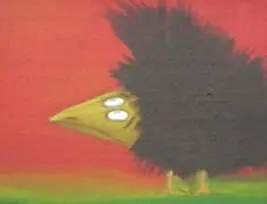
[1] Dee Goong An, three murder cases solved by Judge Dee. An old Chinese detective novel translated from the original Chinese with an introduction and notes, by R. H. van Gulik, Litt.D.; one illustrated vol. publ. Tokyo 1949.
[2]See 'The Chinese Bell Murders'.
[3]In the novel itself all Chinese names are transcribed in such a way, that they can be easily pronounced. In this Postscript, however, I use the regular system of transcription used in most English sinological publications.
